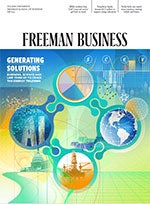
Illustration by Kenneth Harrison.
By Nishad Kapadia
One of my MBA professors defined democracy as the “institutionalization of doubt.” Doubt is perhaps the one thing that is missing from the debate on ESG (Environmental, Social and Governance) investing. Both sides appear convinced they are absolutely correct and that the other side is destroying the very fabric of society. Critics of ESG — such as a group of Republican states that banned Blackrock and other “ESG friendly” asset managers from their state pension plans — argue that considering environmental and social factors violates the fiduciary duty that asset managers have towards their clients. Supporters of ESG, on the other hand, argue that considering these factors results in good corporate citizenship, which benefits investors, employees and communities. In Louisiana, State Treasurer John Schroeder argues that ESG investments result in “blatantly anti-fossil fuel policies [that] would destroy Louisiana’s economy.” Opponents counter that fossil fuels put the future of the entire planet at risk.
So what are the benefits and costs of ESG investing? In her Presidential Address to the American Finance Association earlier this year, University of Texas at Austin Prof. Laura Starks divided the reasons for ESG investing into two categories: Value and Values. Value ESG investors believe that considering these factors helps to either reduce risk or increase returns. In other words, they believe that ESG generates financial value. Values ESG investors, on the other hand, seek to align their financial investments with their ethical beliefs. While these investors do not necessarily believe that ESG investing results in greater financial value, they are happy to invest in this manner because they believe it is the right thing to do.
Even before they were amalgamated together into a fashionable label, however, investors had long considered environmental, social and governance factors in their search for valuable investments. Bad corporate governance, high employee turnover and environmental accidents have always been red flags for investors. In this sense there is nothing new about ESG investing. It’s just a subset of the many variables that investors look at when evaluating an investment.
What is perhaps new is the bubble-like belief that ESG investing will magically deliver returns for all ESG-related variables. Such was the power of the ESG label that “greenwashing” — advertising sustainability without actually delivering it — was born. It became so much of a concern that the SEC enacted a rule to curb such behavior for mutual funds. This is reminiscent of the internet bubble period, when an aptly titled research paper (“A Rose.com by Any Other Name”) showed that firms were generating an increase in market value simply by adding .com to their names.
There are other similarities between the dot-com bubble and ESG investing today. For instance, as a consultant I worked on many internet strategy projects in the late 1990s. Those internet strategy projects eventually dried up, but it wasn’t because the internet was no longer important to those firms. Rather, it was because the internet became just another part of every firm’s overall strategy. Alex Edmans, a professor at the London Business School, makes a similar case for ESG investing in a recent article provocatively titled “The End of ESG.” Edmans argues that although ESG is critically important, there is nothing special about it and ESG variables should just be a part of the regular investing process.
For any variable to result in returns, it must be material for the firm, so that improvements on this dimension lead to greater firm value, and markets must not sufficiently appreciate this link. Not all ESG-related variables will satisfy this, but there is research that shows that some have. For example, Edmans (2011) shows that firms that are on the “100 Best Companies to Work for in America” list deliver excess returns of approximately 2.3% to 3.8% per year. More generally, Khan, Serafeim and Yoon (2016) show that firms with high sustainability scores in areas that are material for the firm outperform those with low scores by about 8.75% per year.
As in the “.com” era, while there is almost certainly over-optimism about what ESG can deliver, there is also a core of long-term value. Three of the largest companies in the U.S. by market capitalization that are together worth around $4 trillion — Google, Amazon and Meta — emerged from the dot-com era. When they were first established, it probably wasn’t clear that they would be the winners, with many of their competitors (remember AOL and Altavista?) falling by the wayside. This is in line with seminal research by Gort and Klepper (1982) and Jovanovic and Macdonald (1994) that documents the lifecycle of a typical industry: An innovation gives birth to the industry, prices fall as more firms enter, and then there is a “shakeout” as many firms exit, leaving a stable industry with a few winners.
I believe that we are in the middle of a such upheaval with the “E” part of ESG. Firms are exploring new business models and new technologies with a core of long-term value beginning to emerge. For example, Tesla is now among the 10 largest companies in the U.S. by market capitalization. In the electricity generation space, my colleague William Waller and I find that over 50% of new generation in the U.S. in each of the last four years has been wind and solar based. The remainder is relatively cleaner natural gas, with virtually no new coal generation added over the last decade. Private equity investors have positioned themselves to take advantage of this trend by funding a significant fraction of this new renewable capacity according to a recent paper by Andonov and Rauh (2023).
There are both risks and opportunities during this upheaval, and while the risks are less discussed, they are arguably as important as the opportunities. Finance theory implies that investors should consider their total risks including human capital in determining their portfolio composition, and financial assets that hedge real risks investors face are valuable. For example, many investors in states like Louisiana are connected to the oil and gas industry in some way, either as employees, suppliers of goods or services, or business owners, and their livelihoods may be at risk if there is a decline in the fossil-fuel industry in the long run. A good hedge against this risk is to invest in renewables in their retirement portfolios. An extreme example of not considering employment risks in investing portfolios were the Enron employees that invested a substantial fraction of their retirement accounts in Enron stock. In the case of Louisiana pension plans, it seems unlikely that moving a few billion dollars in retirement assets to different asset managers will affect the course of the energy transition. However, excluding assets in retirement accounts that allow investors to hedge their fossil fuel-related risk seems problematic because it reduces options to lower the investor’s total risk.
Attacks against ESG investing and the resulting polarization have now led to firms avoiding the term ESG. This may be a good thing, because ESG combines too many disparate factors that are of varying importance to different investors. In fact, we may have come full circle. After greenwashing, some firms are now accused of “green hushing,” or not publicly discussing their green initiatives for fear of controversy.
Ultimately, I believe investors will continue to consider ESG-related factors (even if they don’t use the term ESG) in understanding a firm’s risks and opportunities, and companies will continue to think about their purpose and vision in broader terms than just making as much money as possible in the next quarter. The impact of climate change and the energy transition will continue to be, to employ an appropriate analogy, a slow-moving glacier that impacts firms and markets. The managers of tomorrow will need to be conversant not only in the language of balance sheets and cash flows, but also in the language of greenhouse gases and Scope 1 emissions. Business students today need to learn about the impact of climate change on financial markets to be successful managers in the future. Our newly redesigned full-time MBA curriculum integrates ESG content throughout core courses and features a new concentration in Sustainability to better prepare students to take on these emerging challenges. Regardless of one’s political ideology or economic interest, I feel strongly that students should learn about ESG in a rigorous manner and in a format that enables them to ask questions, express doubts and establish the strong foundation required to navigate the business world of the future.
Nishad Kapadia is an associate professor of finance and holder of the John M. Trapani III Professorship in Business Administration. He teaches the course Climate Change, ESG and Financial Markets.

